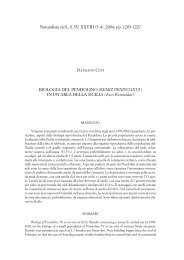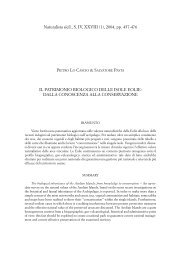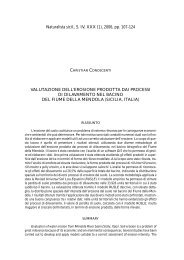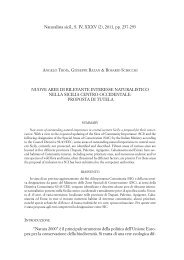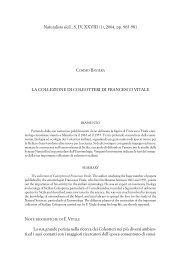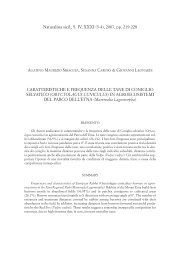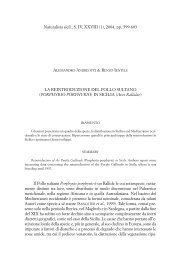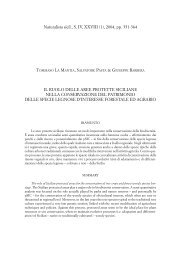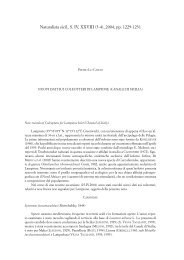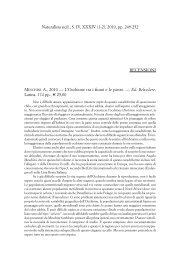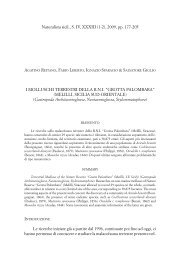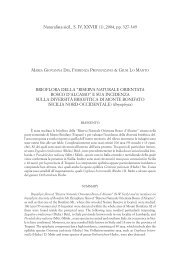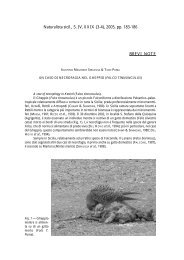PERSICARIA CAPITATA (BUCH.-HAM. EX D - sssn.it
PERSICARIA CAPITATA (BUCH.-HAM. EX D - sssn.it
PERSICARIA CAPITATA (BUCH.-HAM. EX D - sssn.it
Create successful ePaper yourself
Turn your PDF publications into a flip-book with our unique Google optimized e-Paper software.
112 S. PASTA2009) and Italy (CELESTI-GRAPOW et al., 2009), <strong>it</strong> may be assessed that this isnot only the first official record for Sicilian vascular flora, but also for all Centraland Southern Italy. In fact, up to now <strong>it</strong>s presence has been reported onlyfrom Piedmont (AESCHIMANN et al., 2004), while some recent photos on twodifferent national internet s<strong>it</strong>es testify the ongoing naturalization of thisspecies also on two islands of Naples province in Campania (Capri, april2008: cfr. www.naturamed<strong>it</strong>erraneo.com/forum; Ischia, june 2008, GraziaSergi: cfr. www.actaplantarum.org/acta) and along the coasts of Liguria(Zoagli, Genova Province, 200 m a.s.l., january 2011, Daniela Longo: cfr.www.actaplantarum.org/acta).Persicaria cap<strong>it</strong>ata (Fig. 1) is native to the Himalayan area, where <strong>it</strong> growsin N Pakistan, N India, Bhutan, Nepal and W China (QAISER, 2001). Outsideof <strong>it</strong>s natural range this plant prefers full sun, but <strong>it</strong> is able to tolerate partialshade. It often grows on disturbed, rather humid urban places such as rockcrevices, stone walls, roadsides, but <strong>it</strong> also invades subnatural ecosystems likefallows, artificial forests and orchards.Introduced worldwide (LI et al., 2003), mostly as a garden groundcover(GLEASON &CRONQUIST, 1991), once established <strong>it</strong> can be difficult to eradicateas <strong>it</strong> can spread prolifically. During the last two decades <strong>it</strong> performed animpressive colonization success of all the continents, mostly in the biomescharacterized by warm-temperate climate, being recorded as an invasive plantin U.S.A (e.g. West Coast and Hawaii: WESTER, 1992), Central and SouthAmerica (Mexico, Costa Rica, Colombia, Venezuela and Brasil: MEIER, 2003),Taiwan (HSU et al., 2004), Australia and New Zealand (GROVES et al., 2005;HOWELL, 2008), Tropical and South Africa (HENDERSON, 2008). In Europe,this weed is known for Portugal, N Spain, Azores (CASTROVIEJO et al., 1990),Madeira (HANSEN & SUNDING, 1993), Un<strong>it</strong>ed Kingdom (CLEMENT & FOSTER,1994; STACE, 1997) and Greece (STRID & TAN, 1997; ARIANOUTSOU et al.,2010).Once dried, the collected and studied specimen was given to the HerbariumMed<strong>it</strong>erraneum of Palermo (PAL). The label of the exsiccatum containsthe following information: “Centro storico di Palermo, Ist<strong>it</strong>uto d’IstruzioneSuperiore Regina Margher<strong>it</strong>a, cortile interno tra il plesso centrale ed il plesso“Protonotaro”, comun<strong>it</strong>à ruderali su cumuli di sabbia e pietrisco, 20 m s.l.m.,coord. 38°06’86’’ Nord, 13°21’85’’ Est, S. Pasta, 2.III.2012”.Local population of Persicaria cap<strong>it</strong>ata is probably formed by a singleindividual which up to now occupies an area of c. 1 m 2 , where <strong>it</strong> co-occurstogether w<strong>it</strong>h few n<strong>it</strong>rophilous species typical to different classes of synanthropicvegetation such as Parietarietea judaicae Oberdorfer 1977 (chasmon<strong>it</strong>rophilousplant commun<strong>it</strong><strong>it</strong>es), Stellarietea mediae R. Tx. Lohmeyer &Preising ex von Rochow 1951 (annual, herb-rich ruderal commun<strong>it</strong>ies), Poly-



